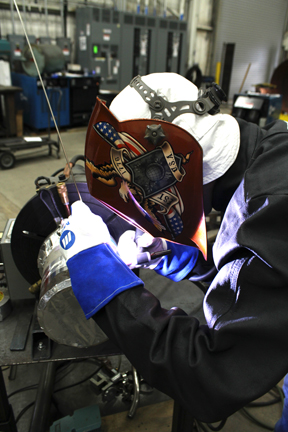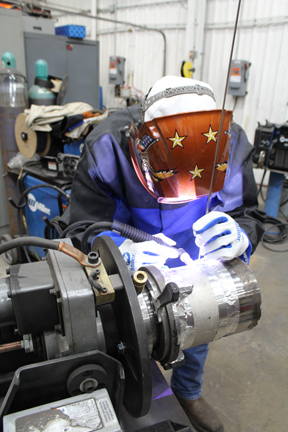Here’s What You Need to Know About How To Weld Stainless Steel
Ideally, the base materials used in a welding application will match perfectly in chemical and mechanical composition. However, companies in manufacturing, fabricating, construction and other industries may occasionally find it necessary — both for cost and service condition requirements — to weld together dissimilar materials. Welding differing materials, such as stainless steel and carbon steel, can be a much more economical choice than fabricating a structure entirely with stainless steel.
The welding of dissimilar materials is common in certain power generation facilities such aspetrochemical refineries, as well as in many mining and mineral processing facilities. The corrosion resistance provided by stainless steel is often necessary for equipment in those facilities. When the environment or service conditions permit, however, the material can be welded to less expensive carbon steel. In these applications, carbon steel, which includes mild and low alloys, serves the important role of reducing costs in constructing and operating these manufacturing plants.

steel and carbon steel, can be a more economical
choice and it can improve durability of the
completed components.
As with any welding application, attaining success when welding dissimilar steels requires the careful selection of filler metals and the proper welding procedures. This holds true regardless of which process the welding application uses.
Note, the topic of joining dissimilar metal spans an enormous number of materials and fabrication processes. The advice and suggestions offered in this article apply to a range of stainless steel and carbon steel, including the commonly used 304L austenitic stainless steel and mild steel combination, as well as mentions of duplex and other such stainless steel grades. Welding operators who are uncertain about an application should always consult with a welding distributor or a filler metal manufacturer for specific welding and filler metal recommendations.
Three factors to remember
When welding stainless steel to carbon steel, it is critical to pay attention to chemistry, mechanical properties and corrosion resistance to avoid potential trouble. For all three factors, choosing the right filler metal can help reduce concerns.
As an example, when joining 304L stainless steel to mild steel, the most commonly recommended filler metal is 309L. During the welding process, the weld becomes diluted with some of the stainless steel from one side of the joint and some of the mild steel from the other side, mixing in material from each side of the weld. The goal is to create a final weld deposit whose chemistry is compatible with each side of the weld joint. Using 309L filler metal achieves this goal when joining 304L stainless steel to mild steel.
Again, if there is uncertainty about the proper filler metal selection, remember to consult with a welding distributor or a filler metal manufacturer prior to attempting the dissimilar weld.
Matching the mechanical properties of each type of material is important, as well. Attaining a mechanical match is a function of having the correct chemistry, and also a reflection of the heat created by the welding procedure. As a general rule, when welding any type of stainless steel to carbon steel, the filler metal should match or slightly exceed the mechanical properties of the weaker of the two materials.
Lastly, it is important when welding stainless steel and mild steel to maintain the corrosion resistance of the weld joint and the nearby stainless steel base metal.
Heat input is important
To address the factors of chemistry, mechanical properties and corrosion resistance, it is important to follow a suitable welding procedure that limits the heat input to the weld and stainless base material. Limiting the heat input reduces dilution of the weld deposit with the mild steel portion of the weld joint. This in turn helps maintain the alloy content of the weld deposit and its desired corrosion resistance.
In the case of some stainless steels, moderate heat input also protects the corrosion resistance byavoiding the creation of undesirable phases in the stainless steel side of the joint. For example, 300 series austenitic stainless steels are subject to carbide precipitation if held too long in a critical temperature range of 800 degrees to 1400 degrees Fahrenheit. Minimizing the time in this range — and selecting a low carbon base metal and filler metal — can prevent this problem from occurring. The use of stabilized grades of filler metals (ER321 or ER347, for example) may also be warranted, and can serve as added insurance to avoid carbide precipitation.

oxidation, stainless steel to carbon steel welds
with open root joints should be shielded from
the atmosphere on the backside of the weld
(back purging).
Other stainless steel grades may form undesirable phases that result in brittleness or poor corrosion resistance if held too long at a high temperature. Sigma phase (a brittle, intermetallic phase with high hardness) can form in some stainless grades at elevated temperatures and can seriously compromise mechanical and corrosion resistance properties. In duplex stainless steels, for example, the heat input is responsible for the balance between ferrite and austenite in the final weld and heat-affected zone (HAZ). The proper level of heat input can help to maintain the desired amount of each phase in the finished weld and base metal HAZ.
Pitfalls to avoid: warping, cracking and oxidation
Stainless steel has a high coefficient of thermal expansion, a measure that refers to the rate at which a material expands with changes in temperature. In short, stainless steel expands and contracts more with temperature changes in comparison to carbon steel.
Stainless steel also has about half the thermal conductivity of carbon steel. Because of that lack of thermal conductivity, a piece of hot stainless steel will remain hot for much longer because it doesn’t conduct heat away from the source as quickly. Since carbon steel has more thermal conductivity, heat conducts along that piece relatively quickly, drawing heat away from the weld zone.
Differences in the coefficient of thermal expansion and the thermal conductivity can cause some difficulty when welding dissimilar materials. Stainless steel will naturally want to expand and contract more as a result of the high heat seen during welding. Conversely, carbon steel (particularly mild steel) is a good conductor of heat and therefore will cool more rapidly and shrink faster as the joint cools. These differences add to the stress on the joint, created as both sides expand with heat and contract with cooling. This can cause warping or misalignment of a dissimilar metal weld. It can also cause cracking if the stresses created by differences in thermal expansion and contraction exceed the strength of either material.
To address these two issues when welding stainless steel to carbon steel, avoid highly restrained joints that create high stresses as the joint is heated and cools down. If a highly restrained joint configuration is required, use modest heat input and some pre-heating to delay cooling of the joint after welding is completed. Insulating the weld joint after the last weld pass also will slow cooling and help prevent thermal stresses from cracking a joint.
Contamination of the weld joint and resulting weld is a serious problem that often causes ‘hot’ cracking. Contaminants can react with the carbon steel or stainless steel to produce minute amounts of weld material with drastically lower melting temperatures. These microscopic areas of low-melting-point contaminants are the last to freeze as the weld cools. As a result, they can become cracks as the weld metal cools and shrinks. These hot cracks can be easily seen if the problem is severe, but they can also be micro-cracks that are invisible to the naked eye.
When it comes to protecting the material from oxidation, these dissimilar metal welds should be treated just as a stainless weld would. Open root joints should be shielded from the atmosphere on the backside of the weld (back purging). The practice of back purging, most frequently used when TIG welding, helps prevent contamination of the weld from behind the joint. Otherwise, the weld joint and stainless steel side of the weld can be damaged by oxidation, which is the result of a reaction with oxygen and nitrogen in the atmosphere. Oxidation will damage the corrosion resistance of the weld and stainless steel HAZ. To prevent this from occurring, purge the back of the joint with an inert gas such as argon, or use one of the commercially available coatings that can be applied to the back of a weld joint prior to welding.
Preparation for stainless steel to carbon steel welding
Proper cleaning and preparation are vital steps to help ensure successful welding of dissimilar materials. Grind the mill scale or coatings back by at least 1/2 inch on each side of the joint. Follow this task by cleaning the area with a solvent such as alcohol or acetone. These steps help get rid of grease and oil, which tend to carry the phosphorous and sulfur that are the primary causes of hot cracking.
Welding dissimilar metals requires planning
Welding dissimilar metals can be a challenge. It is important to have as much information as possible about the characteristics of the base materials and the filler metal in order to make appropriate choices that yield successful welds. When in doubt, consult with a trusted welding distributor for advice on the process. Doing so can help ensure the durability — and the cost-savings — sought in an application featuring both stainless steel and carbon steel.
Related Articles:
Choosing the Right Welding Process for Stainless Steel
New Regulated Metal Deposition (RMD™) MIG Welding Process Improves Stainless Steel Pipe Fabrication



